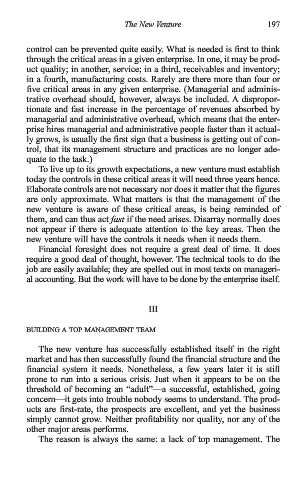Page 204 - ENTREPRENEURSHIP Innovation and entrepreneurship
P. 204
53231_Innovation and Entrepreneurship.qxd 11/8/2002 10:50 AM Page 197
The New Venture 197
control can be prevented quite easily. What is needed is first to think
through the critical areas in a given enterprise. In one, it may be prod-
uct quality; in another, service; in a third, receivables and inventory;
in a fourth, manufacturing costs. Rarely are there more than four or
five critical areas in any given enterprise. (Managerial and adminis-
trative overhead should, however, always be included. A dispropor-
tionate and fast increase in the percentage of revenues absorbed by
managerial and administrative overhead, which means that the enter-
prise hires managerial and administrative people faster than it actual-
ly grows, is usually the first sign that a business is getting out of con-
trol, that its management structure and practices are no longer ade-
quate to the task.)
To live up to its growth expectations, a new venture must establish
today the controls in these critical areas it will need three years hence.
Elaborate controls are not necessary nor does it matter that the figures
are only approximate. What matters is that the management of the
new venture is aware of these critical areas, is being reminded of
them, and can thus act fast if the need arises. Disarray normally does
not appear if there is adequate attention to the key areas. Then the
new venture will have the controls it needs when it needs them.
Financial foresight does not require a great deal of time. It does
require a good deal of thought, however. The technical tools to do the
job are easily available; they are spelled out in most texts on manageri-
al accounting. But the work will have to be done by the enterprise itself.
III
BUILDING A TOP MANAGEMENT TEAM
The new venture has successfully established itself in the right
market and has then successfully found the financial structure and the
financial system it needs. Nonetheless, a few years later it is still
prone to run into a serious crisis. Just when it appears to be on the
threshold of becoming an “adult”—a successful, established, going
concern—it gets into trouble nobody seems to understand. The prod-
ucts are first-rate, the prospects are excellent, and yet the business
simply cannot grow. Neither profitability nor quality, nor any of the
other major areas performs.
The reason is always the same: a lack of top management. The

